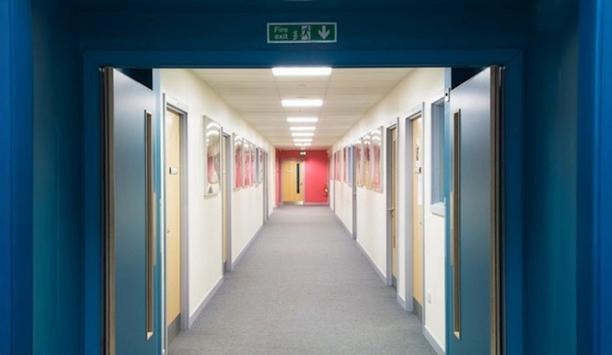Fire dampers are safety devices installed in the ductwork of buildings to prevent the spread of fire and smoke through the ventilation system. When a fire is detected, these dampers close automatically, limiting the potential damage of the fire. Fire dampers play a vital role in maintaining buildings' structural integrity and safety during a fire.
M&G Fire Protection has been protecting life and property for over 25 years. The experienced damper team each has at least ten years of experience in ductwork, and they share some of their experiences, knowledge, and advice.
Which Buildings need Dampers?
Dampers are essential in various buildings, including commercial, residential, healthcare, hospitality, leisure, and educational facilities. Buildings with complex layouts and extensive ductwork need these devices, as they are placed inside the ductwork that passes through fire compartment walls and floors. This 'traps' the fire in the affected area, preventing it from starting in one room and eventually spanning the whole property.
Types of Fire Dampers
At M&G, they install and maintain all types of dampers. The primary types are:
- Electrical Fire and Smoke Dampers: These systems can be centrally controlled and managed by a Building Management System (BMS), and faults can be located. The dampers can also be connected to the building's fire alarm system and trigger when the fire detectors are in an alarm state.
- Mechanical Fire Dampers: These dampers are triggered by a 'fusible link' when the temperature increases beyond a set parameter, most commonly between 75⁰C and 100⁰C; this consists of a piece of metal that keeps the damper open, and when high heat is applied, the metal piece breaks, and causes the shutters to close.
Smoke dampers can be configured to open instead of close during a fire event. This helps the ventilation system channel the smoke out of the building.
Maintenance, Testing, and Compliance
The guidelines for the maintenance and testing of dampers are in BS 9999 and BESA's (Building Engineering Services Association) VH001 Technical Bulletin. These guidelines require all dampers to be tested at a minimum annually.
- Identification: finding the location of dampers in the building
- Inspection: a visual check of the installation and state of repair
- Testing: a physical drop test to ensure that each Fire Damper device is operating correctly, and the internal cleanliness of the damper is recorded as heavy contamination of dirt and dust can prevent it from fully closing, allowing smoke and fire to pass
- Resetting: replacing the fire damper to its 'ready' state if required
- Reporting: Record maintenance is an essential element of compliance. Building owners are now legally required to store these records digitally so everything is traceable, and someone is accountable
Despite these guidelines, it is common for building owners to neglect these tests due to financial constraints, lack of knowledge, bad practices, and flawed building design. This not only violates safety standards but also poses significant legal and safety risks.
Problem #1: Neglecting Annual Testing
One of the primary issues they see is that many buildings do not conduct the necessary annual tests
One of the primary issues they see is that many buildings do not conduct the necessary annual tests on their fire dampers. Financial limitations are often cited as the reason, but this neglect clearly violates safety standards. With the amendment to the Building Safety Act of October 2023, which enforces stricter regulations, non-compliance can lead to severe legal repercussions, including prosecution of building owners. Fortunately, these more stringent laws have prompted many to take their responsibilities more seriously, ensuring their fire dampers are tested and maintained regularly.
Problem #2: Damaged Dampers
Another significant problem is the presence of broken fire dampers, which can lead to inadequate airflow within the building. This results in uncomfortable conditions, such as overheated rooms, pioneering occupants to devise dangerous makeshift solutions, and throughout the years, they have seen it all. For example, they have seen numerous apartment blocks that have trapped open their dampers with utensils, compromising the fire protection system and putting everyone in the building at greater risk in the event of a fire. It is crucial to immediately address and replace any damaged dampers to maintain safety and comfort.
Problem #3: Design Flaws
The dampers were located behind toilets, making them inaccessible without costly modifications
The damper engineer will need access to the building's technical drawings to see an accurate representation of the ductwork design and to determine the quantity and location of the fire dampers installed throughout the building. However, design issues are another common challenge – particularly in older buildings. Although, they recently visited a care home that was just one year old, and at least 50% of the dampers were inaccessible, meaning they couldn't test them. In this building, the dampers were located behind toilets, making them inaccessible without costly modifications that the client would not want to pay for. They have also been at an old hotel where 80% of the dampers were inaccessible. This complicates maintenance, as reporting on inaccessible dampers takes just as long, if not longer, than testing them. It also poses a significant risk, as unmaintained dampers may malfunction in an emergency.
They've worked on some higher-risk buildings in which the client has agreed to pay to fit access doors to the ductwork to make it accessible for testing and cleaning. Some buildings cannot get insurance without such modifications.
Solutions and Recommendations
To address these issues, they recommend the following steps:
- Regular Testing and Maintenance: Follow the annual testing requirements strictly to ensure all fire dampers are in working order.
- Immediate Repairs: Replace any damaged dampers promptly to avoid compromising the building's fire safety system.
- Design Considerations: During the design phase of new buildings, ensure that fire dampers are accessible for future maintenance and testing. This foresight can prevent costly modifications and ensure compliance with safety standards.
- Digitally Store Service Reports: After each service visit, they provide clients with a comprehensive digital service report detailing the condition and accessibility of each damper. This helps building owners prove that they have done their due diligence and had their dampers tested.
Fire dampers are a critical component of a building's fire safety strategy. Regular maintenance, timely repairs, and thoughtful design can significantly enhance their effectiveness, ensuring the safety and well-being of building occupants.















